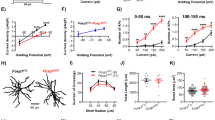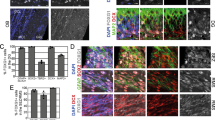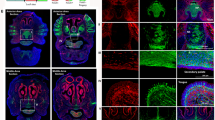Abstract
FOXG1 syndrome is caused by FOXG1 intragenic point mutations, or by long-range position effects (LRPE) of intergenic structural variants. However, the size of the FOXG1 regulatory landscape is uncertain, because the associated topologically associating domain (TAD) in fibroblasts is split into two domains in embryonic stem cells (hESC). Indeed, it has been suggested that the pathogenetic mechanism of deletions that remove the stem-cell-specific TAD boundary may be enhancer adoption due to ectopic activity of enhancer(s) located in the distal hESC-TAD. Herein we map three de novo translocation breakpoints to the proximal regulatory domain of FOXG1. The classical FOXG1 syndrome in these and in other translocation patients, and in a patient with an intergenic deletion that removes the hESC-specific TAD boundary, do not support the hypothesised enhancer adoption as a main contributor to the FOXG1 syndrome. Also, virtual 4 C and HiC-interaction data suggest that the hESC-specific TAD boundary may not be critical for FOXG1 regulation in a majority of human cells and tissues, including brain tissues and a neuronal progenitor cell line. Our data support the importance of a critical regulatory region (SRO) proximal to the hESC-specific TAD boundary. We further narrow this critical region by a deletion distal to the hESC-specific boundary, associated with a milder clinical phenotype. The distance from FOXG1 to the SRO ( > 500 kb) highlight a limitation of ENCODE DNase hypersensitivity data for functional prediction of LRPE. Moreover, the SRO has little overlap with a cluster of frequently associating regions (FIREs) located in the proximal hESC-TAD.
Similar content being viewed by others
Log in or create a free account to read this content
Gain free access to this article, as well as selected content from this journal and more on nature.com
or
References
Dixon JR, Selvaraj S, Yue F, et al. Topological domains in mammalian genomes identified by analysis of chromatin interactions. Nature. 2012;485:376–80.
Rao SSP, Huntley MH, Durand NC, et al. A 3D map of the human genome at kilobase resolution reveals principles of chromatin looping. Cell. 2014;159:1665–80.
Miyoshi G, Fishell G. Dynamic FoxG1 expression coordinates the integration of multipolar pyramidal neuron precursors into the cortical plate. Neuron. 2012;74:1045–58.
Lupiáñez DG, Kraft K, Heinrich V, et al. HHS public access. 2016;161:1012–25.
Shoichet SA, Kunde SA, Viertel P, et al. Haploinsufficiency of novel FOXG1B variants in a patient with severe mental retardation, brain malformations and microcephaly. Hum Genet. 2005;117:536–44.
Alosi D, Klitten LL, Bak M, Hjalgrim H, Møller RS, Tommerup N. Dysregulation of FOXG1 by ring chromosome 14. Mol Cytogenet. 2015;8:24.
Redin C, Brand H, Collins RL, et al. The genomic landscape of balanced cytogenetic abnormalities associated with human congenital anomalies. Nat Genet. 2016;49:36–45.
Allou L, Lambert L, Amsallem D, et al. 14q12 and severe Rett-like phenotypes: new clinical insights and physical mapping of FOXG1-regulatory elements. Eur J Hum Genet. 2012;20:1216–23.
Lettice LA, Daniels S, Sweeney E, et al. Enhancer-adoption as a mechanism of human developmental disease. Hum Mutat. 2011;32:1492–9.
Ibn-Salem J, Köhler S, Love MI, et al. Deletions of chromosomal regulatory boundaries are associated with congenital disease. Genome Biol. 2014;15:423.
Schmitt AD, Hu M, Jung I, et al. A compendium of chromatin contact maps reveals spatially active regions in the human genome. Cell Rep. 2016;17:2042–59.
Dekker J, Marti-Renom MA, Mirny LA. Exploring the three-dimensional organization of genomes: interpreting chromatin interaction data. Nat Rev Genet. 2013;14:390–403.
Dixon JR, Jung I, Selvaraj S, et al. Chromatin architecture reorganization during stem cell differentiation. Nature. 2015;518:331–6.
Kimura-Yoshida C, Kitajima K, Oda-Ishii I, et al. Characterization of the pufferfish Otx2 cis-regulators reveals evolutionarily conserved genetic mechanisms for vertebrate head specification. Development. 2004;131:57–71.
Kleinjan DA, Van Heyningen V. Long-range control of gene expression: emerging mechanisms and disruption in disease. Am J Hum Genet. 2005;76:8–32.
Kortüm F, Das S, Flindt M, et al. The core FOXG1 syndrome phenotype consists of postnatal microcephaly, severe mental retardation, absent language, dyskinesia, and corpus callosum hypogenesis. J Med Genet. 2011;48:396–406.
Papa FT, Mencarelli MA, Caselli R, et al. A 3 Mb deletion in 14q12 causes severe mental retardation, mild facial dysmorphisms and rett-like features. Am J Med Genet Part A. 2008;146:1994–8.
Ariani F, Hayek G, Rondinella D, et al. FOXG1 is responsible for the congenital variant of Rett syndrome. Am J Hum Genet. 2008;83:89–93.
Mencarelli MA, Spanhol-Rosseto A, Artuso R, et al. Novel FOXG1 mutations associated with the congenital variant of Rett syndrome. J Med Genet. 2010;47:49–53.
Yeung A, Bruno D, Scheffer IE, et al. 4.45 Mb microduplication in chromosome band 14q12 including FOXG1 in a girl with refractory epilepsy and intellectual impairment. Eur J Med Genet. 2009;52:440–2.
Takagi M, Sasaki G, Mitsui T, Honda M, Tanaka Y, Hasegawa T. A 2.0Mb microdeletion in proximal chromosome 14q12, involving regulatory elements of FOXG1, with the coding region of FOXG1 being unaffected, results in severe developmental delay, microcephaly, and hypoplasia of the corpus callosum. Eur J Med Genet. 2013;56:526–8.
Ellaway CJ, Ho G, Bettella E, et al. 14q12 microdeletions excluding FOXG1 give rise to a congenital variant Rett syndrome-like phenotype. Eur J Hum Genet. 2012;21:522–7.
Goubau C, Devriendt K, Van der Aa N, et al. Platelet defects in congenital variant of Rett syndrome patients with FOXG1 mutations or reduced expression due to a position effect at 14q12. Eur J Hum Genet. 2013;21:1349–55.
Bisgaard A, Kirchhoff M, Tumer Z, et al. Additional chromosomal abnormalities in patients with a previously detected abnormal karyotype, mental retardation, and dysmorphic features. Am J Med Genet. 2006;140:2180–7.
Adesina MD, Veo BL, Girard Courteau G, et al. FOXG1 expression shows correlation with neuronal differentiation in cerebellar development, aggressive phenotype in medulloblastomas, and survival in a xenograft model of medulloblastom. Hum Pathol. 2015;46:1859–71.
Ahlgren S, Vogt P, Bronner-Fraser M. Excess FoxG1 causes overgrowth of the neural tube. J Neurobiol. 2003;57:337–49.
Brunetti-Pierri N, Paciorkowski A, Ciccone R, et al. Duplications of FOXG1 in 14q12 are associated with developmental epilepsy, mental retardation, and severe speech impairment. Eur J Hum Genet. 2011;19:102–7.
Amor D, Burgess T, Tan T, Pertile M. Questionable pathogenicity of FOXG1 duplication. Eur J Hum Genet. 2012;20:595–6.
Won H, Torre-Ubieta L, Stein JL, et al. Chromosome conformation elucidates regulatory relationships in developing human brain. Nature. 2016;538:1–20.
Boggio EM, Pancrazi L, Gennaro M, et al. Visual impairment in FOXG1-mutated individuals and mice. Neuroscience. 2016;324:496–508.
Shen L, Nam H, Song P, Moore HAS. Results in impaired neurogenesis in the postnatal hippocampus and contextual memory deficits. Hippocampus. 2006;16:875–90.
Thurman R, Rynes E, Humbert H, et al. The accessible chromatin landscape of the human genome. Nature. 2012;489:75–82.
Zepeda-Mendoza CJ, Ibn-Salem J, Kammin T, et al. Computational prediction of position effects of apparently balanced human chromosomal rearrangements. Am J Hum Genet. 2017;101:206–17.
Visel A, Minovitsky S, Dubchak I, Pennacchio LA. VISTA enhancer browser-a database of tissue-specific human enhancers. Nucleic Acids Res. 2007;35:D88–92.
Acknowledgements
We thank the patients and family members for participating in this study.
Funding
This work was supported by The Lundbeck Foundation [2013–14290]; the University of Copenhagen’s Programme for Interdisciplinary Research (Global Genes, Local Concerns); The Danish Council for Independent Research—Medical Sciences [4183-00482B]; FAPESP—Fundação de Amparo à Pesquisa do Estado de São Paulo (Grants: CEPID-Human Genome and Stem Cell Research Centre 2013/08028-1; student fellowships 2011/14293-4 and 2013/01146-9); the BIH-Charité Clinical Scientist Programme funded by the Charité—Universitätsmedizin Berlin and the Berlin Institute of Health.
Author information
Authors and Affiliations
Corresponding author
Ethics declarations
Conflict of interest
The authors declare no conflict of interests.
Electronic supplementary material
41431_2017_11_MOESM5_ESM.eps
Chromatin interaction loops, ENCODE DNaseI Hypersensitivity Sites, and Frequently Interacting Regions (FIREs) in Domains A and B
Rights and permissions
About this article
Cite this article
Mehrjouy, M.M., Fonseca, A.C.S., Ehmke, N. et al. Regulatory variants of FOXG1 in the context of its topological domain organisation. Eur J Hum Genet 26, 186–196 (2018). https://doi.org/10.1038/s41431-017-0011-4
Received:
Revised:
Accepted:
Published:
Issue date:
DOI: https://doi.org/10.1038/s41431-017-0011-4
This article is cited by
-
Chromosomal structural rearrangements implicate long non-coding RNAs in rare germline disorders
Human Genetics (2024)
-
Abnormal Chromatin Folding in the Molecular Pathogenesis of Epilepsy and Autism Spectrum Disorder: a Meta-synthesis with Systematic Searching
Molecular Neurobiology (2023)
-
Diagnosis of FOXG1 syndrome caused by recurrent balanced chromosomal rearrangements: case study and literature review
Molecular Cytogenetics (2020)
-
Prioritization of genes driving congenital phenotypes of patients with de novo genomic structural variants
Genome Medicine (2019)



